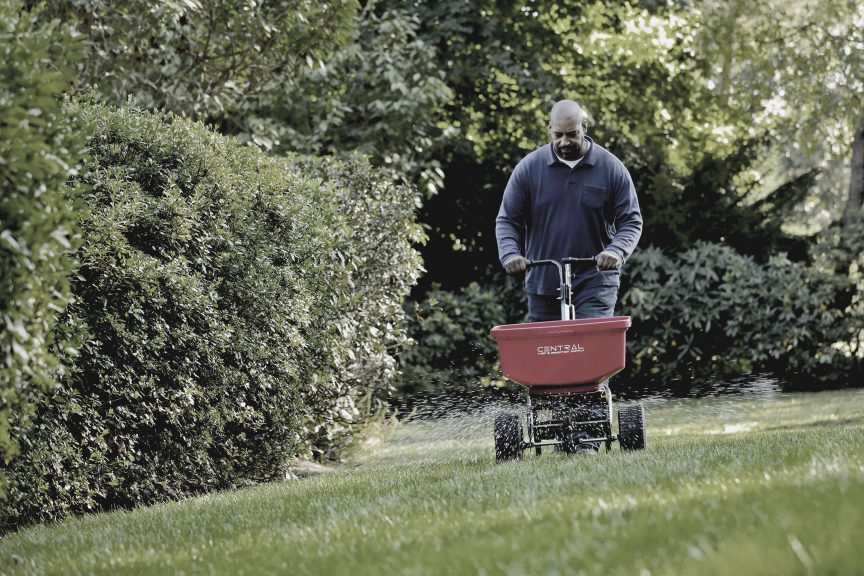With Groundhogs Day behind us and Punxsutawney Phil predicting an early spring, now is the time to start tackling your to-do list for the upcoming season.
Last month we spoke about business planning and making sure that you plan out your year for things like your marketing strategy, assessing your service portfolio, and developing new customer leads. But, there are also more tactical items that you and your team need to prepare for such as education on new products or making sure equipment is ready for the season.
We’ve connected with our Director of Turf, Bob Hartman, to learn how spreader calibration can increase efficiency and profitability this season.
From Bob:
Why Does a Spreader Need Calibration?
As a spreader ages with wear and tear, its condition may affect the flow and rate of material applied to the turf. Spreaders must be properly calibrated if they are to deliver granular fertilizers and pesticides to turf at the correct label rates. If calibration is done incorrectly or it is not done at all, the product may be misapplied and either too much or too little of the product will reach the turf which could become costly. Spreaders can be calibrated in several ways, but the following methods are relatively simple, fast, and accurate. You may need a scale for weighing the material to accurately calibrate and measure product output
It is always important to calibrate new spreaders. During shipping, a spreader can move and shift throughout the transit process. That shifting can and most likely will, change the factory calibration. Also, many spreaders are shipped unassembled. The way the spreader is assembled can also affect calibration, so it is always necessary to calibrate after assembly. Even if you bought your spreader fully assembled, don’t assume it is calibrated properly. Finally, spreaders can also be whacked out of calibration by normal wear and tear of loading and unloading out of your vehicle.
Calibration Basics
Regardless of the spreader type or model you use, each individual spreader is slightly different from all others. Therefore, you should calibrate each and every spreader separately, even though it may appear to be identical to another spreader.
Fertilizer and pesticide manufacturers often provide recommended spreader settings on their product labels. Although these spreader settings are a useful starting point in the calibration process, a recommended setting should not be trusted to deliver the desired amount of product, primarily because of differences in ground speed among operators and differences among spreaders. We recommend that spreaders should be calibrated separately for each operator.
Even the most experienced applicators occasionally miss a few areas and overlap unnecessarily, which can result in alternating light and dark green stripes in the turf, inconsistent weed & pest control, or could even lead to turn burn. To minimize these problems, it is best to make two coverage passes, with the second pass being at right angles to the first. The resulting grid pattern has the effect of masking skips or overlaps made in either coverage pass. If you choose this approach, calibrate the spreader to deliver half the desired rate of fertilizer, then cover the entire area twice.
To obtain the best results from your granular fertilizers and pesticides, you have to apply them at the correct rate. If you apply a rate that is too low, you may not get turf response; if you overapply, you waste material which leads to lost profit and the risk turf damage. One easy step you can take to help assure that your spreader delivers the correct rate of material is to calibrate your spreader.
Can All Spreaders Be Calibrated?
Not all spreaders can be calibrated. If your spreader allows recalibration, you should take advantage of that feature.
How Do You Calibrate a Spreader?
To find out if your spreader can be calibrated and how to do it, consult your spreader operator’s manual. See the websites below for recommendations and caliber settings.
Calibration is the best way improve and maximize performance of your spreader. It takes only a few of minutes and helps you apply the recommended amount of material to the turf. It is always best to check your spreader’s calibration at least once a year.
Additional Resources for Calibration:
https://extension.psu.edu/calibrating-your-fertilizer-spreader
http://www.simplot.com/pdf/best/useful_info/fert_spreader_calibration.pdf
https://www.pubs.ext.vt.edu/content/dam/pubs_ext_vt_edu/430/430-017/430-017_pdf.pdf
http://www2.ca.uky.edu/agcomm/pubs/AGR/AGR211/AGR211.pdf
About Bob Hartman
Bob Hartman is an industry veteran with more than 15 years of experience in the green industry; specifically turf. Bob brings a solid background in both the organic and synthetic methods of feeding turf and plants. His diverse background and experience on the manufacturing makes him an excellent resource to help you grow your business.
Finally, rely on Central to help, whether it’s questions about the newest innovations in agronomics, organic & low-impact programs, or finding the right solutions for a problem area. We stay at the leading edge of the industry and we’re ready to help you grow!

